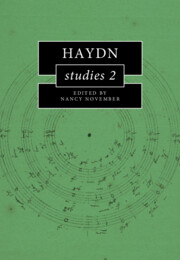Book contents
- Haydn Studies 2
- Haydn Studies 2
- Copyright page
- Contents
- Figures
- Tables
- Music Examples
- Contributors
- Acknowledgements
- 1 The Many Haydns of Musicology
- 2 Understanding Haydn’s Il ritorno di Tobia through Tonkünstler-Societät Oratorio Traditions Established by Its Founder Florian Leopold Gassmann
- 3 Listening Again to Haydn’s Night Watchman
- 4 Haydn’s Last Heroine: Hanne, The Seasons, and the Culture of Sensibility
- 5 Framing Haydn: Canons ‘As Pictures’ in the Composer’s Kabinett
- 6 Haydn in Plain Sight: A Reception History of Matisse’s The Music Lesson
- 7 The Premiere of Haydn’s Orfeo in Florence (1951)
- 8 ‘So Elusive and Yet So Palpable’: Performers Imagine Haydn
- 9 ‘Admired across the Sea’: Importing Late Haydn into Early New Zealand
- Select Bibliography
- Index
- References
Select Bibliography
Published online by Cambridge University Press: 18 October 2025
- Haydn Studies 2
- Haydn Studies 2
- Copyright page
- Contents
- Figures
- Tables
- Music Examples
- Contributors
- Acknowledgements
- 1 The Many Haydns of Musicology
- 2 Understanding Haydn’s Il ritorno di Tobia through Tonkünstler-Societät Oratorio Traditions Established by Its Founder Florian Leopold Gassmann
- 3 Listening Again to Haydn’s Night Watchman
- 4 Haydn’s Last Heroine: Hanne, The Seasons, and the Culture of Sensibility
- 5 Framing Haydn: Canons ‘As Pictures’ in the Composer’s Kabinett
- 6 Haydn in Plain Sight: A Reception History of Matisse’s The Music Lesson
- 7 The Premiere of Haydn’s Orfeo in Florence (1951)
- 8 ‘So Elusive and Yet So Palpable’: Performers Imagine Haydn
- 9 ‘Admired across the Sea’: Importing Late Haydn into Early New Zealand
- Select Bibliography
- Index
- References
Information
- Type
- Chapter
- Information
- Haydn Studies 2 , pp. 233 - 253Publisher: Cambridge University PressPrint publication year: 2025
